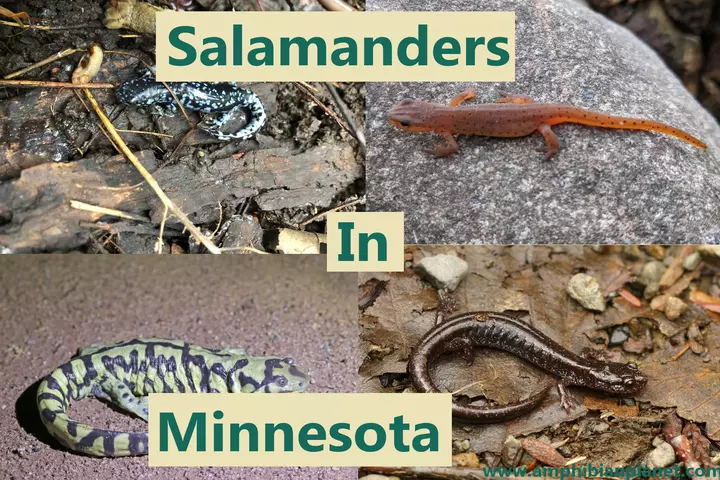The state of Minnesota is home to eight species of salamanders. Seven of these species are terrestrial, which means they live on land, but there is also one fully aquatic species.
Most terrestrial salamander species typically inhabit shady, forested areas, not far from a water source – and often hide in moist locations such as under rocks, logs, and other debris.
You are most likely to encounter one of these salamanders in the spring because that is when they are most active.
Since there are so many different salamander species, the exact size and coloration varies between species.
Native Salamanders of Minnesota
As earlier mentioned, Minnesota is home to at least 8 salamander species, some species more common than others.
If you ever spot a salamander in Minnesota, It’s probably one of these. You can potentially see salamanders of any age or gender!
1. Red-Backed Salamander

| Scientific Name | Plethodon Cinereus |
| Average Adult Size (Length) | 2– 5 inches |
| Average Lifespan (Years) | 15 – 20 |
Red-backed salamanders have slender bodies and reach between 3 and 4 inches in length. They are typically gray or black in color – and despite their name, not all “red-backed ” salamanders have the color red on their backs.
They have many color variations but mainly have two variations: The red-back, and the lead- morph.
The red-back morph has a straight-edged reddish stripe (sometimes orange, yellow, or dark gray) running the length of its back from the base of the head to the tail, with dark sides.
The lead-back morph, on the other hand, lacks the red stripe. It has a purely dark gray to black color on its back instead.

There also exists a morph where the whole body of the salamander is a pinkish red, sometimes with black spots.
In Minnesota, red-backed salamanders can be found mostly in the northeastern parts of the state.
Red-Backed Salamander Range. Map By: United States Geological Survey.
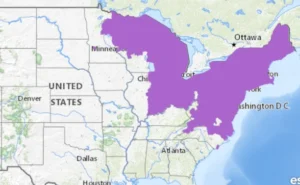
2. Blue-Spotted Salamander

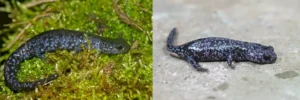
| Scientific Name | Ambystoma Laterale |
| Average Adult Size (Length) | 3– 5 inches |
| Average Lifespan (Years) | 10 – 15 |
Blue-spotted salamanders are relatively slender salamanders ranging from 3 to 5 inches in length. They have a long fleshy tail (accounting for about 40% of the total body length) that is broadly oval at the base and compressed towards the tip.
These salamanders have a gray to blue-black coloration with blue spots on their sides, tails, and legs (hence their name).
Blue-spotted salamanders inhabit a wide variety of habitats, which include damp woodlands, deciduous hardwood forests, and even the edges of some open fields.
However, due to habitat loss, these salamanders are threatened in many states. Minnesota is one of the few states where blue-spotted salamanders are still very common. They can be found throughout much of the eastern, northeastern and central parts of the state.
Blue-spotted Salamander Range. Map By: United States Geological Survey.

3. Spotted Salamander


| Scientific Name | Ambystoma Maculatum |
| Average Adult Size (Length) | 6 – 9 inches |
| Average Lifespan (Years) | 15 – 20 |
Spotted salamanders (sometimes called “yellow-spotted salamanders“) are fairly large, ranging from 6 to 7 inches long, with females typically larger than males.
They get their name from the two roles of yellow or orange spots speckled along their black backs and sides. Their underside is pale gray with no spots.
Spotted salamanders have broad heads and thick, heavy bodies with vertical grooves on each side of their body.
In Minnesota, spotted salamanders are only found in a few forested areas in eastern Carlton and Pine counties.
Spotted Salamander Range. Map By: United States Geological Survey.

4. Eastern tiger salamander (Ambystoma Tigrinum Tigrinum)
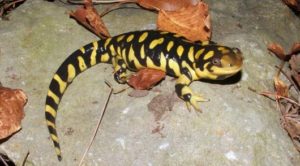
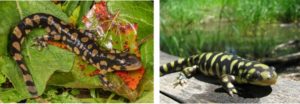
| Scientific Name | Ambystoma Tigrinum Tigrinum |
| Average Adult Size (Length) | 6 – 9 inches |
| Average Lifespan (Years) | 15 – 25 |
Eastern tiger salamanders typically range from 6 to 9 inches but can grow up to 13 inches, which makes them the largest terrestrial salamanders in Minnesota
These salamanders can be easily identified by their dull brown coloration, with olive-yellow to brownish-yellow irregular blotches (“tiger stripes”), and a yellow underside.
Some tiger salamanders may have brilliant golden yellow or light brown blotches, while others may be extremely dark with very little noticeable patterning.
Eastern tiger salamanders can be found throughout much of Minnesota, except the northeastern parts of the state.
Eastern Tiger Salamander Range. Map By: United States Geological Survey.
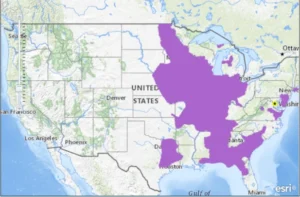
5. Western Tiger Salamander

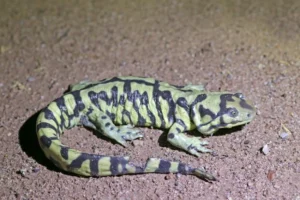
| Scientific Name | Ambystoma Mavortium |
| Average Adult Size (Length) | 6 – 9 inches |
| Average Lifespan (Years) | 15 – 25 |
Western tiger salamanders Barred tiger salamanders are sometimes called “barred tiger salamanders”. As their name suggests, these salamanders are subspecies of tiger salamander and are very closely related to the Eastern tiger salamander.
Western tiger salamanders grow 6 to 9 inches in length and have a gray, dark brown, or black coloration, with olive-yellow to brownish-yellow irregular bars and spots. The underside is yellow.
Since these salamanders look very similar to the eastern tiger salamander, the main way you can tell these two subspecies apart is by their coloration:
- Eastern tiger salamanders have lots of yellow spots or blotches on their body
- Western tiger salamanders have few yellow blotches, and the botches frequently form “bars”
In Minnesota, western tiger salamanders are restricted to only a small part of the southwestern region of the state.
Western Tiger Salamander Range. Map By: United States Geological Survey.
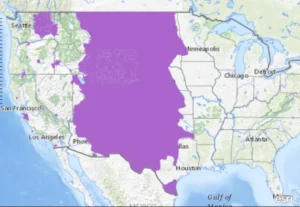
6. Four Toed Salamander


| Scientific Name | Hemidactylium Scutatum |
| Average Adult Size (Length) | 2– 4 inches |
| Average Lifespan (Years) | Unknown, but estimated to be 8 – 12 |
Four-toed salamanders range from 2 to 4 inches in length. They get their name from the four toes on both their front and hind feet. (Most salamanders have five toes on the back feet, and four on the front feet).
Four-toed salamanders have a reddish-brown or gray-brown coloration on the back, with gray sides and a white belly with black spots.
These salamanders also have an obvious constriction at the base of the tail where it can detach if grabbed by a predator, allowing the salamander to escape.
In Minnesota, four-toed salamanders can be found in limited areas of the eastern part of the state.
Four-toed Salamander Range. Map By: United States Geological Survey.

Newts in Minnesota
Salamanders are often informally divided into two groups: “Newts” and “true salamanders”.
True salamanders typically have smooth moist skin while newts tend to have more rough, grainy skin. In simple terms, newts are a specific type of salamander.
There is only one species of newt in the state of Minnesota.
7. Central Newt (Notophthalmus Viridescens Louisianensis)
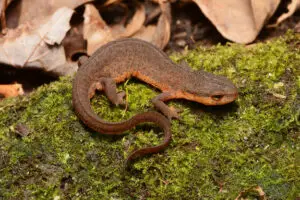
| Scientific Name | Notophthalmus viridescens louisianensis |
| Average Adult Size (Length) | 2 – 4 inches |
| Average Lifespan (Years) | 12 -15 |
Central newts are a subspecies of the eastern newt. They grow between 2 and 4 inches in length and have an olive-brown coloration with fine black dots all over the body. Some individuals may have very small red spots bordered with black along the back on both sides of the spine.
The underside is a bright orange-yellow and is noticeably lighter than the rest of the body.
In the Juvenile eft stage (which lasts about 3 to 4 years), central newts have a dull brown to reddish-brown coloration with a rounded tail.

As adults, their tail is less rounded and is paddle-shaped to help them swim as these newts are highly aquatic.
Central newts are found in the eastern part of Minnesota – and are often found not very far from a water source.
Eastern Newt Range. (Central Newt Range Is in Purple).

Aquatic Salamanders in Minnesota
Unlike terrestrial salamanders, aquatic salamanders live entirely in the water, even after transforming into adults. This means they have features that are adapted for life in the water, rather than on land.
Aquatic salamanders have more varied features than terrestrial salamanders. Some aquatic salamanders have 4 legs, but others only have forelegs and lack hind legs. Some have gills, but others do not and largely breathe underwater through their skin.
However, despite their varied features, all aquatic salamanders have flat paddle-like tails which they use to swim in their aquatic environments.
There is only one aquatic species of salamander in the state of Minnesota.
8. Mudpuppy (Necturus Maculosus)


| Scientific Name | Necturus Maculosus |
| Average Adult Size (Length) | 7 – 16 inches |
| Average Lifespan (Years) | 15 – 30 |
Mudpuppies reach 7 to 16 inches and are one of the few salamanders that are vocal. They get their name from their squeaky scream which sounds somewhat like a dog’s bark.
Their large size makes them the largest species of salamander – and the largest species of amphibian in the state of Minnesota.
Mudpuppies are fully aquatic for their whole lives and retain their larval features even as adults. They have large feathery gills, four legs, and a flat fin that runs down the length of their body.
Their coloration is usually brownish-black with bluish-black spots or blotches. However, younger mudpuppies are often black with yellow stripes running along the length of their bodies.
Mudpuppies can be found in clear creeks, rivers, deep inland lakes, and other cool, oxygen-rich waters in limited areas of Minnesota.
Mudpuppy Range. Map By: United States Geological Survey.
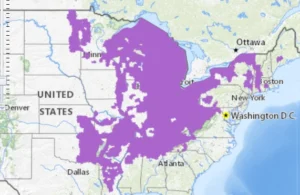
Frequently Asked Questions (FAQS)
Are there salamanders in Minnesota? Yes, there are salamanders in the state of Minnesota. Eight salamander species are native to Minnesota; most of these salamanders are found in the northeastern part of the state where they inhabit shady, forested areas, not far from a water source.
What kind of salamanders live in Minnesota? Most of the salamanders that live in Minnesota are terrestrial. Some of the kinds of salamanders that live in Minnesota are the red-backed salamander, blue-spotted salamander, spotted salamander, tiger salamander, and the four-toed salamander. The mudpuppy is the only aquatic salamander species in Minnesota.
Rare salamanders in Minnesota? While many species of salamander found in the state of Minnesota are widespread, some such as the spotted salamander, the western tiger salamander, and the four-toed salamander are rare and not frequently encountered.
Conclusion
Minnesota has 8 salamander species, with some being more widely distributed and more common their others.
Most of Minnesota’s salamanders are terrestrial – which means they live on land, but there are also one fully aquatic species.
If you want to see these salamanders, go looking in moist locations such as under rocks, logs, and other debris. You are most likely to find them in the spring months when they are most active.
Have fun herping!

